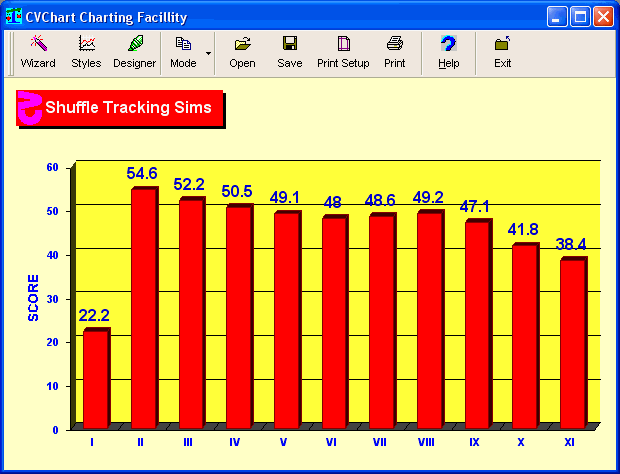Cost of Errors when Shuffle Tracking
This page contains a series of Blackjack Shuffle Tracking simulations
to get a sense of the cost of making errors. The Blackjack rules are a
fairly standard 4.5/6, S17, DAS. For this study I wanted to work with
a simple shuffle and procedure. So, I used a simple one pass rifle &
restack with four grabs from each stack. (Yes this shuffle still exists,
albeit rarely.) The Trackzone is the bottom 39 cards. A bad slug is cut
out of play and a good slug is cut one deck from the top. A spread of
1:15 was used, HiLo was the counting system with 20 accurate indices,
and NRS was used for playing and betting through the play zones. The dealer
accuracy in performing the shuffle was set to typical riffle accuracy
and a fairly tight plus or minus 8 cards on the split and plus or minus
3 cards on the grabs. Only one track zone was used. Every shuffle was
cut according to track zone content.
The Sims
Eleven sims were performed as follows:
- I. Standard card counting, no shuffle tracking.
- II. Extended NRS used with a multiplier of -1.4 and an adjustment
of .2. (This is the extended NRS adjustment used to take into account
the count of the cards before the play zone starts and is typically
not used by shuffle trackers.)
- III. Standard NRS used with a compromise -1.5 multiplier and no adjustment.
(This is the benchmark. All further sims were run in this manner.)
- IV. Play zone +6. That is, the play zone starts 6 cards late.
- V. Cut +6. That is, the cut is made 6 cards too deeply.
- VI. Cut -6.
- VII. Play zone length +12. That is, ending the play zone 12 cards
late. Note: I generally set the PZ length about 6 cards short to avoid
zone edge problems. Thus, +12 is not as far off as it sounds. Although
a few STers seek to make use of the count differences at zone edges,
I believe most do not.
- VIII. Track zone -6. That is, the TZ is 6 cards short.
- IX. Track zone +6
- X. Combination of Cut +6 and PZ +6.
- XI. No Play zone at all with a good slug. The bad slugs are still
cut out of play.
The Chart
Below you will see the SCORE for each sim:

Comments
- 1. First the obvious. At least with this simple scenario, shuffle
tracking can be very profitable. However, be warned that this is hardly
a common shuffle these days.
- 2. An improvement from standard NRS to extended NRS exists, but is
not great. However, had I cut the good slugs further into the shoe the
gain from extended NRS would have been greater.
- 3. Generally speaking, the overall cost of errors was not that bad.
However, it should be noted that this is hardly a comprehensive study
as only one shuffle was included. A smaller track zone, or a more diluted
play zone would be likely to experience much greater error effects.
- 4. In this series, an error in the track zone length was more severe
than errors in locating the play zone. This is good news as TZ location
is generally the easier task.
- 5. Combinations of errors can have a much greater impact than single
errors. This is hardly surprising as multiple errors can multiply the
effect.
- 6. Comparing sims II, X and XI we see that nearly all of the gain
of cutting good cards into play can be lost by two errors.
- 7. Even with no attempt at cutting good cards into play, the SCORE
was dramatically improved. This is great news as cutting bad cards out
of play is vastly easier than cutting good cards into play and using
NRS methodology to bet through the play zone. In fact, a lone player
that cannot simultaneously keep track of both a play zone and track
zone in one shuffle might be better off only cutting bad cards out of
play instead of tracking every other shuffle.
Caveat
Again, this is hardly a comprehensive study. There are a huge number
of variables in standard Blackjack card counting simulations. This is
multiplied considerably in shuffle tracking sims. For the purposes of
this sim, only one shuffle and one method of attacking the shuffle were
used. Further, only one fairly tight dealer was used.
|

